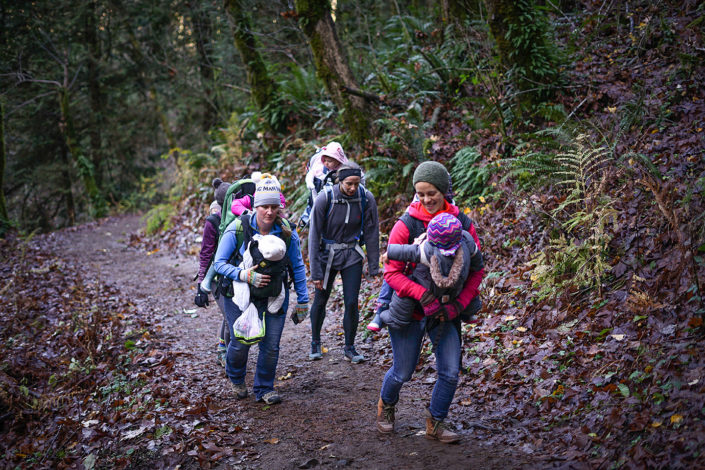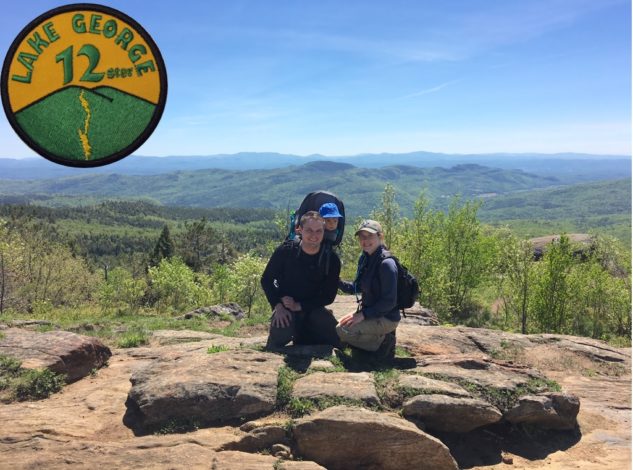Hiking Challenges to Get Your Family Outside in 2018
As another year comes to a close and we reflect back on what we have accomplished (or failed to accomplish), many of us look to the new year as a fresh start and a way to better ourselves. In other words, it’s “New Year’s Resolution” time. Each year, similar themes are to increase health, decrease stress and spend more quality time with family and friends. We think there is a way to encompass all three of these themes into one resolution: take on an outdoor or hiking challenge!
Don’t just take our word for it. Scientific studies provide evidence supporting the powerful positive effects of getting outside all year-round. Numerous studies illustrate the physical health benefits of spending time outdoors, such as reduced inflammation and anti-cancer benefits, while other studies focus on the mental health benefits of enjoying nature, such as a reduction in stress and a restored mental energy.
Looking for hiking challenges to motivate you to get outside all year round? We've compiled a list of awesome, family-friendly outdoor and hiking challenges for you. Challenge yourself this year to increase health, decrease stress and spend quality time making memories with your loved ones. (Did we miss a hiking challenge you participate in? Comment below!)

If you have participated in a HiB30 challenge, you may have noticed that many people add personal challenges on top of the original challenge. Many strive for “no zero days” (spending time outside every day), while some visit three new-to-them trails during the challenge month. This makes the challenge more meaningful, and it is fun to share your progress and gain motivation from others through the challenge's social media pages. We're blessed to have a variety of State and National Park Lands that are open to the public. Our family has started the tradition of visiting as many State and National Park lands whenever we travel. Both park systems have passport and/or stamp programs where you can document your visit.

Hike it Baby 30 Challenges
Not sure where to start when making your outdoor resolutions? The Hike it Baby 30 challenge is the perfect launching point to kick-start a year full of fun outdoor adventures! We host four Hike it Baby 30 challenges throughout the year, and our next one starts January 1, 2018. This membership-based challenge encourages families to get their children outside for 30 miles in 30 days or 30 minutes three times a week. Cost: $10 is recommended, but you can choose to pay anywhere from $5-$50. Participation comes with a challenge sticker, access to the motivational challenge Facebook group, discounts on rad gear, an online log to track progress and an opportunity to win one of dozens of prizes from our sponsors.10K Women Trail Project
Hike it Baby launched the 10K Women Trail Project with the goal of getting more women and girls on trails all across North America. We aim to see if, together, we can inspire 10,000 women to hike and log their adventures in 2018 by encouraging their female friends and family to get on a trail at least once a month. The 10K Women Trail Project is funded by an REI #ForceofNature grant, which strives to ensure women and men are equally inspired and equipped to embrace life outside. Cost: FREE and comes with access to a motivational Facebook group and an online log to track your progress.Women Who Hike
The Women Who Hike Challenge (#WWHChallenge) is a new challenge where you can pick your own goal - a short term hiking goal, a long term hiking goal or a non-hiking goal. So, no matter where you are in your journey both on and off the trail, you can join. The current challenge runs January 9th through February 9th. Cost: Suggested $15 to become a Women Who Hike member.Mountain Mom and Tots Monthly Challenges
Looking for more monthly challenges? The mom behind the popular outdoor blog Mountain Mom and Tots has set up some awesome challenges each month to help families explore the outdoors. While the challenges differ month to month, each one has four main aspects: 1) they require you to get outside, 2) they will be something you can bring kids on, 3) they will cost nothing or very little to complete, and 4) they will be a little challenging … it is a challenge after all! The challenges can range anywhere from hiking five miles to completing a nature photo scavenger hunt, or even taking a nap outside! If you complete the challenge and post a photo to social media, you are entered to win an exclusive gear giveaway where your chances of winning are always 1 in 50 or better. Cost: FREE.52 Hike Challenge
With the 52 Hike Challenge, challenge your family to complete 52 hikes in a year. “The 52 hike challenge is a global movement empowering you to take a personal journey to discover the physical, mental, and spiritual benefits gained through hiking once a week for an entire year.” They offer multiple challenges depending on experience level, but they suggest starting with the original challenge of 52 hikes in 52 weeks. This challenge runs for a year, but can start at any time throughout the year. Each Hike it Baby branch strives to hold at least one hike a week throughout the year, making this challenge even more doable as part of your outdoor resolutions! Cost: FREE365 Mile Challenge
The 365 Mile Challenge was started by a group of busy moms who also happen to be outdoor bloggers. You may recognize some of their popular blogs: Hike Like a Woman, The Kid Project, Go Adventure Mom, Tales of a Mountain Mama and Currently Wandering. The goal is to get outdoors and move one mile a day in 2018. These miles must be self-propelled, such as hiking, biking or snowshoeing; but activities like snowmobiling don't count. This challenge runs from January 1 to December 31. Cost: $25 which gets you exclusive discounts, access to the Facebook group for motivation, entry into prize drawings, and more.100 Hours Unplugged
The 100 Hours Unplugged challenge is difficult (especially in our technology-rich world), but hear me out. O.A.R.S. Whitewater Rafting Adventures started the initiative and encourages participants to go a full 100 hours completely UNPLUGGED. That means no screen time whatsoever for 100 hours. According to studies, on a typical week, only 6 percent of children ages 9-13 play outside on their own, and kids 8 to 18 spend an overwhelming 53 hours a week using entertainment media. For many families, this challenge may seem impossible, but why not plan an extended summer camping or adventure trip? The results have the potential to be profound, and you may be surprised how your family dynamics change! Cost: FREE.Adventure Mamas
Adventure doesn't end when motherhood begins. Adventure Mamas Initiative is working to redefine motherhood and to empower women to live a balanced, adventurous, authentic life. Looking for a new challenge or epic adventure in 2018? Adventure Mamas hosts both single-day adventure workshops as well as longer expedition-style adventures. Join their epic winter expedition in February - an Intro to Backcountry Travel, Mountaineering, and Ice Climbing or connect with a local colab for events near you. Cost: Varies by expedition, FREE to join your local colab.Local Challenges
Depending on where you live, you may often hear about different “challenges” in your area. These can range from family-friendly challenges, such as visiting all of the fire towers or waterfalls in the area, to more intense challenges, such as scaling all of the 14,000-foot mountains in your state. For example, my family and I took on the Lake George 12ster challenge for 2017 (reaching the peak of the 12 most popular mountains in Lake George, NY). It was such an incredible experience that brought us so much closer as a family! I heard about this challenge through my Hike it Baby branch Facebook group. Similarly, you can also do a quick online search to see what challenges are available near you. Cost: Varies depending on the challenge, though many are free to join. Create Your Own Challenge
Create Your Own Challenge
If you have participated in a HiB30 challenge, you may have noticed that many people add personal challenges on top of the original challenge. Many strive for “no zero days” (spending time outside every day), while some visit three new-to-them trails during the challenge month. This makes the challenge more meaningful, and it is fun to share your progress and gain motivation from others through the challenge's social media pages. We're blessed to have a variety of State and National Park Lands that are open to the public. Our family has started the tradition of visiting as many State and National Park lands whenever we travel. Both park systems have passport and/or stamp programs where you can document your visit.
Outdoor Mom Academy
The Outdoor Mom Academy is a bit different from the others listed above. It focuses on teaching participants the skills needed to confidently explore the outdoors as a family. The Outdoor Mom Academy is a six-week online course led by three very knowledgeable outdoor moms: Susan from Mountain Mom and Tots, Rebecca from Hike Like a Woman and Amelia from Tales of a Mountain Mama. Topics include raising outdoor leaders, how to pack what you need, family adventures on a budget, camping made simple, first aid and identifying and mitigating risk in the outdoors. These self-paced lessons and discussions provide an in-depth coverage from women who have experienced the highs and lows of outdoor family adventures. The next session begins in May, with signups starting in April. Cost: ~$99 for the entire 6-week course and includes materials.Start 2018 Off with a First Day Hike
Regardless of which challenge(s) you choose to aim for in 2018, why not hit the ground running with a First Day Hike? As part of American Hiking Society’s “First Day Hikes” initiative, hundreds of free, America's State Parks will organize guided hikes across all 50 states on New Year’s Day. Find a First Day Hike near you. In addition, many Hike it Baby branches will host hikes, so be sure to check the hike calendar.Read more
- First Day Hikes and New Years Resolutions
- 10 Ways to Have a Positive Hike it Baby Environmental Impact in the New Year
Photos by Kim Ives and Rebecca Hosley.
How do you plan on making getting outdoors part of your 2018 resolutions? What hiking challenges would you add to the list? Let us know in the comments below!Related Content




Comments